












Shipmates I am so proud to be part of Iwi Heramana and Te Taua Moana O Aotearoa. And I remain humbled by the privilege and honour to have served as Chief of Navy of the Royal New Zealand Navy.
I am writing my last Yours Aye here in Aotearoa. My first was written in Valparaíso, Chile, where I travelled to the day after I assumed Command in 2018. The Armada de Chile (Chilean Navy) was celebrating its 200th anniversary. The opportunity so early in my time as Chief, to meet so many of my Indo-Pacific and Commonwealth senior leader colleagues, set a great foundation for increased cooperation and collaboration with navies whom the RNZN shares traditions, values and strong security links.
Given current world events, what I stated then is arguably even more pertinent today: “Similar to our everyday personal lives, effective relationships are important in the international arena. Military and security relationships, associated trust and mutual respect – all are as useful to Aotearoa’s future prosperity as diplomatic and economic engagement.” What our Navy delivers to New Zealand is critical to our national success.
To that end, I note nearly 20 percent of our sailors are at sea or deployed on operations as I type this message. Some are half the globe away supporting high end military operations, others are closer in the region working alongside our Pacific partners delivering security outcomes, and many are around New Zealand undertaking preparedness training. Be it at the individual, unit/ship, or collective level, being ready to respond locally in the community, or to use our unique high-end

maritime combat capabilities that our government has invested in, our duty is clear – be ready to serve as and where directed. I am very comfortable that we are clearly and tangibly providing maritime military effect to Aotearoa and thereby contributing to peace and prosperity at home, in the region and globally.
As I reflect on my service, I note the Navy has often faced challenges… and I note through most of my career I have thought “it’s a great time to be in the Navy”. This might seem a bit counterintuitive or a contradiction, but I do not think so. Notwithstanding the demands of the time, I have always had faith in my shipmates, comrades and leaders that the Navy (and NZDF) will respond as best it can to the situation and move ahead positively – and in almost every instance we have. As we face the current demanding environment, I am secure in my assessment that through you, the leaders in our Navy (and every sailor is a leader!), we should be confident we will overcome the challenges, deliver what the nation needs, and, the mana of our Navy will be enhanced. I remain of the opinion that it is a great time to be in the Navy.
As I depart the fix (an old navigation term) and explore new adventures out of uniform, I ask you, my comrades in uniform, to continue doing one of the things I asked of you in 2018; spin dits – spin dits publicly! Much of what we do as a Navy is done over the horizon out of sight. Accordingly, our fellow citizens often wonder what we do… and what they get for the investment of precious treasure in the Navy. We have great people, doing amazing things every day, and I remain committed to the critical importance of all sailors, not just senior leaders, getting out and talking to our friends and the public – tell them of the awesome things we/you do and how it contributes to the maintenance of peace our national prosperity.
In closing, to you and your whānau, thank you for your commitment, sacrifice, friendship and service. It has been a privilege to do my mahi alongside you. It has been my honour to serve.
He
heramana ahau. Rear Admiral David Proctor Chief of Navy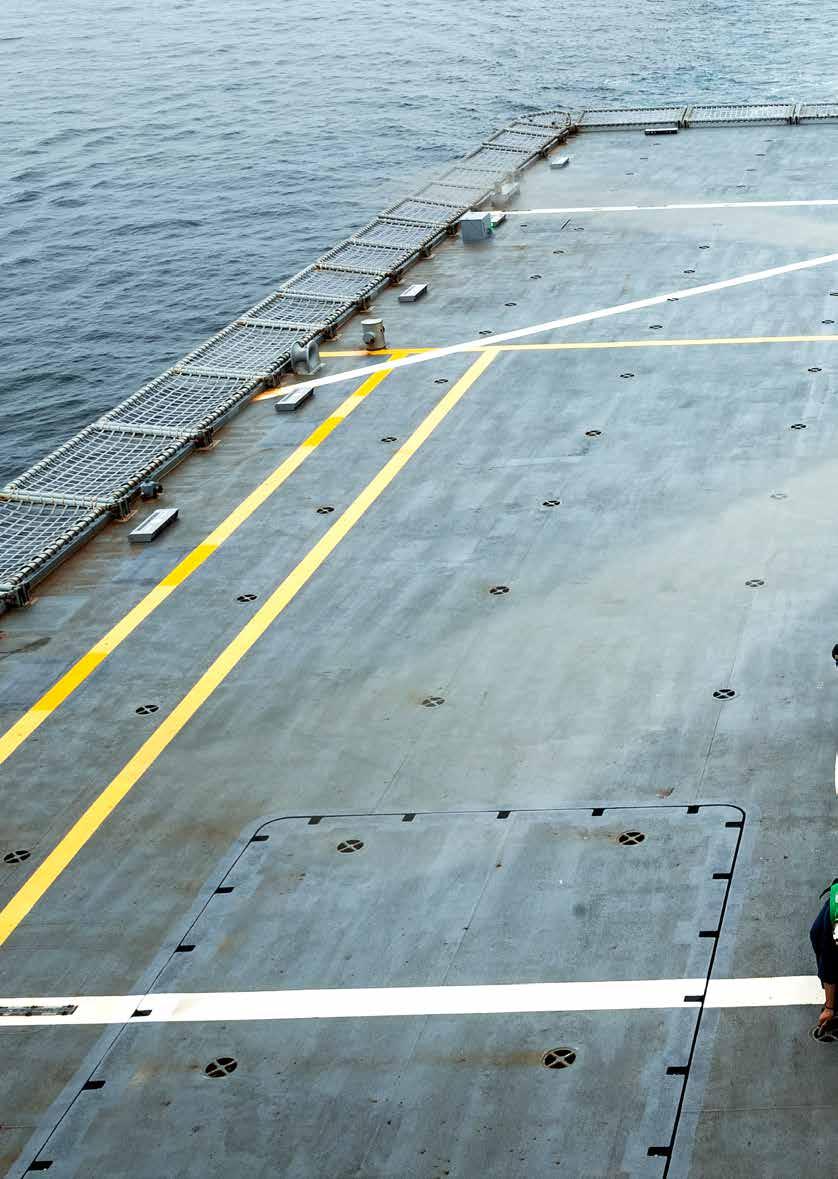
Helicopter operations will be a vital part of CANTERBURY’s deployment to Solomon Islands.
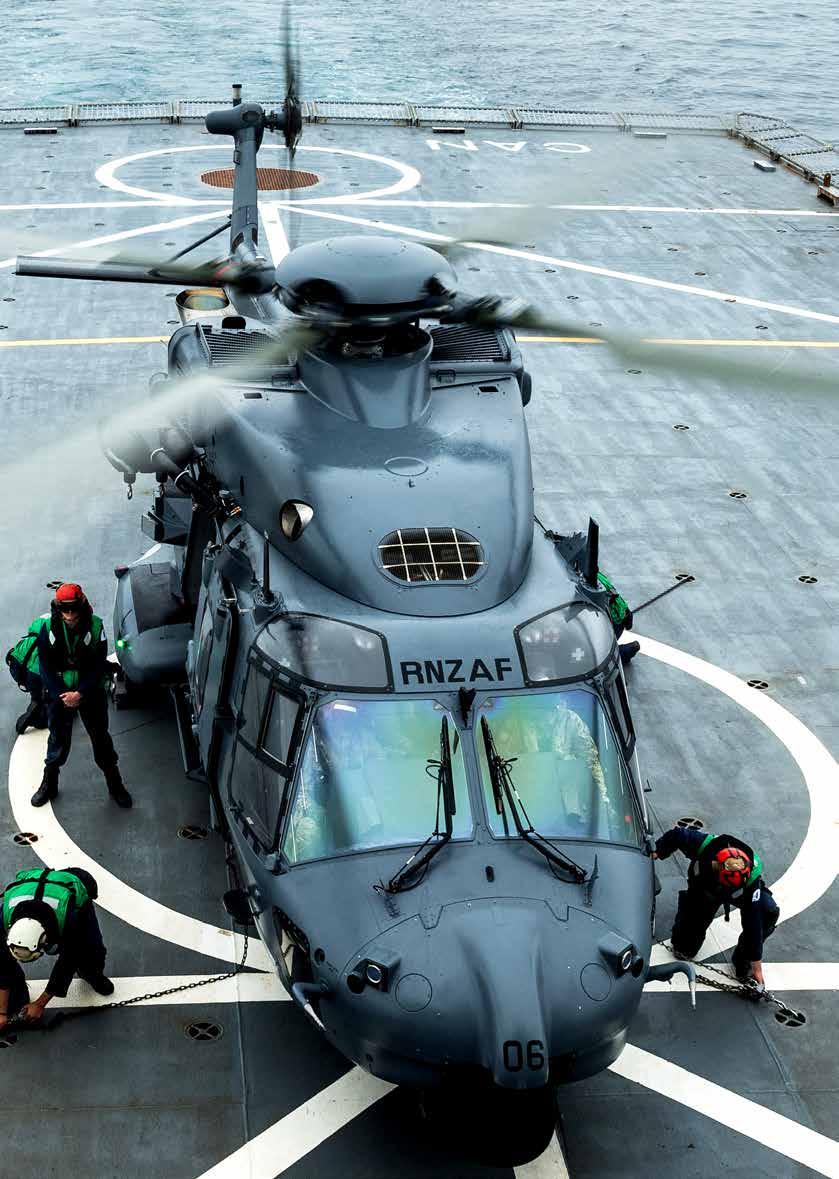
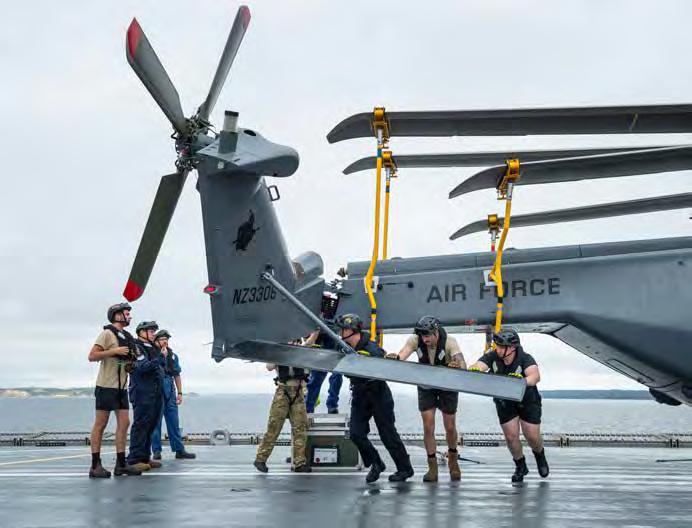
HMNZS CANTERBURY and RNZAF No. 3 Squadron demonstrated how well they gel during a Sea Acceptance and Readiness Check (Aviation) over a working week in March in the Hauraki Gulf.
During the week No. 3 Squadron and CANTERBURY’s Ship’s Company conducted NH90 helicopter flight serials to and from the ship’s flight deck, including winching exercises, to achieve an Authority to Operate Helicopters while at sea. The effort was part of the build-up to Operation Moa, with the ship and No. 3 Squadron deploying to the Solomon Islands to assist in general election logistics.
Commanding Officer CANTERBURY, Commander Bronwyn Heslop, was delighted to achieve the tick from the Maritime Training Group so quickly.


We got the tick Wednesday morning, and that’s pretty fast for a SARC Aviation. The team bonded really quickly.”
– Commander Bronwyn Heslop

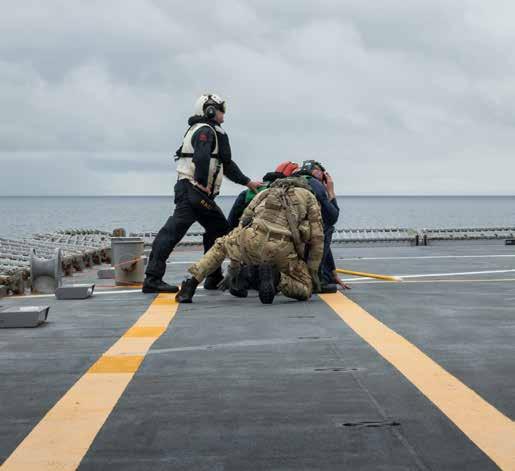
The ship had departed Devonport on Monday and would probably have achieved the qualification by Tuesday if weather hadn’t closed in.
She’s had No. 3 Squadron on board three times so far in her time as Commanding Officer. In November 2022 the squadron underwent a similar exercise to prepare for the summer cyclone season, and were then embarked in CANTERBURY in March–April 2023 for Exercise Mahi Tahi, which involved working alongside Fijian military to train personnel in amphibious operations and humanitarian and disaster relief work.
During the SARC, No. 3 Squadron qualified four pilots and 10 helicopter loadmasters in ship’s operations. The ship also conducted internal training including boat operations, multiple damage control serials, and Engineering Casualty Control Drills (machinery breakdown exercises), topping off the week with a welldeserved Flight Deck barbecue.
The ship found time for some special guests during the week, with a team from Māori TV recording for children’s Māori language show Pūkana, using fluent Te Reo speakers among the crew.
This month HMNZS CANTERBURY and two embarked NH90 helicopters from No. 3 Squadron transported election officers and materials around Solomon Islands, as part of a logistics support package to the Islands’ elections on April 17.
Defence Minister Judith Collins said the support was at the request of the Solomon Islands’ Electoral Commission, and part of a NZD$10.8 million election support programme announced in January.
“It was an excellent opportunity for our personnel to work again with the Solomon Islands’ Government and alongside Australian counterparts in support of regional peace and security,” she said.
At time of going to print HMNZS CANTERBURY was enroute to Honiara, and the activities will feature in May’s Navy Today edition.
Foreign Minister Winston Peters said the support programme included funding towards the Commission’s election preparation and management, technical support from the New Zealand Electoral Commission, and an independent observer mission.
“New Zealand’s overall contribution will support the Commission to lead the delivery of a safe and successful election. It demonstrates New Zealand’s commitment to a resilient democracy in Solomon Islands and the wider Pacific region.”
New Zealand has a long history of supporting elections in the Pacific, including providing a similar level of logistics support during Solomon Islands 2019 election alongside the Australian Defence Force.

The Royal New Zealand Navy is once again providing a fullyequipped, bespoke boarding capability to Pacific-based Royal Navy vessels.
This month, River-class Offshore Patrol Vessel HMS TAMAR trained with HMNZS MATATAUA’s Deployable Boarding Team in the Hauraki Gulf, in preparation for fisheries patrols in Fiji. Last year the team trained with sister ship HMS SPEY. The two ships rotate crews to sustain a permanent roving Royal Navy presence in the Indo-Pacific.
Working from TAMAR, the Deployable Boarding Team accompanied Ministry for Primary Industries Fishery Officers in boarding and searching Vessels of Interest, with NZ Customs vessel HAWK V and HMNZS CANTERBURY posing as vessels with potential ‘illegal’ fishing hauls.
The scenarios were planned, overseen and assessed by the Maritime Training Group and the Royal Navy’s Fleet Operational Safety Training team (FOST), who were able to fly to New Zealand to partner the assessment.
At time of writing TAMAR was in Fiji with the Deployable Boarding Team and a Fijian Fisheries Officer on board to conduct joint fisheries patrols around Fiji’s islands, helping the nation build up their capacity to curb illegal fishing.


MATATAUA’s Deployable Boarding Teams were stood up last year as a specialist capability, providing a readyto-go ‘fly-in, fly out’ team capable of supporting a Royal New Zealand Navy ship on operation or the vessels of partner nations.
Commanding Officer Maritime Training Group, Commander Andy Dowling, said it was good to work with the FOST as both countries had similar systems.
Commander Tom Gell, Commanding Officer TAMAR, says working with the Royal New Zealand Navy is like working with colleagues. “The training we executed in the Hauraki Gulf with the RNZN Deployable Boarding Team and the RNZN Maritime Training Group has been outstanding.”
“It has also been fantastic to see the Royal Navy’s FOST organisation and the Maritime Training Group come together to deliver world-class training. TAMAR and her Ship’s Company have really benefitted.
“Overall the welcome and support we have received from our RNZN brothers and sisters has been awesome. The partnership between our two navies continues to flourish.”
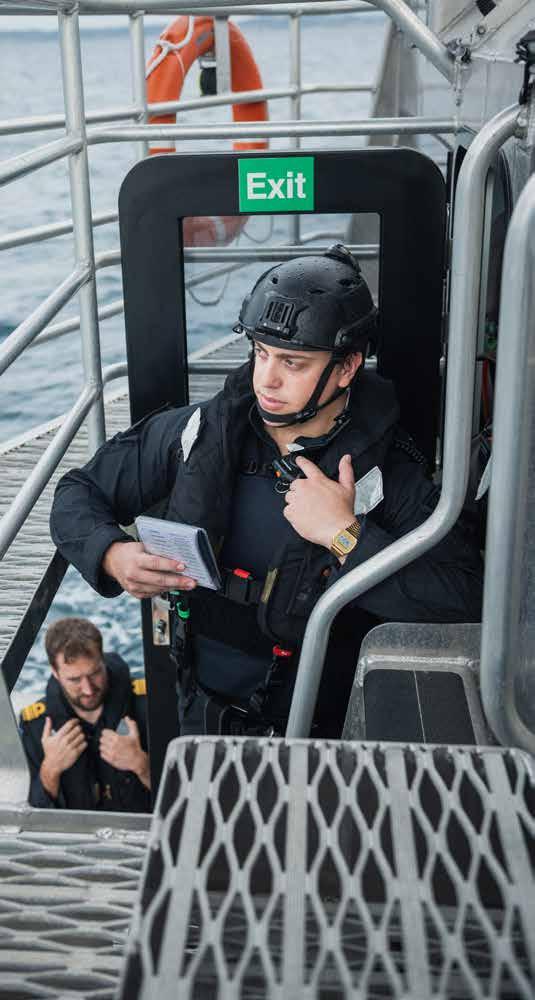
This kind of engagement opens up opportunities to work together in future and creates possibilities of exchanges between our two navies. It confirms each countries’ standard operating procedures and ways of doing things, and each of us can learn and adapt useful practices from the other. Overall, both units were very much on the same page.”
– Commander Andy Dowling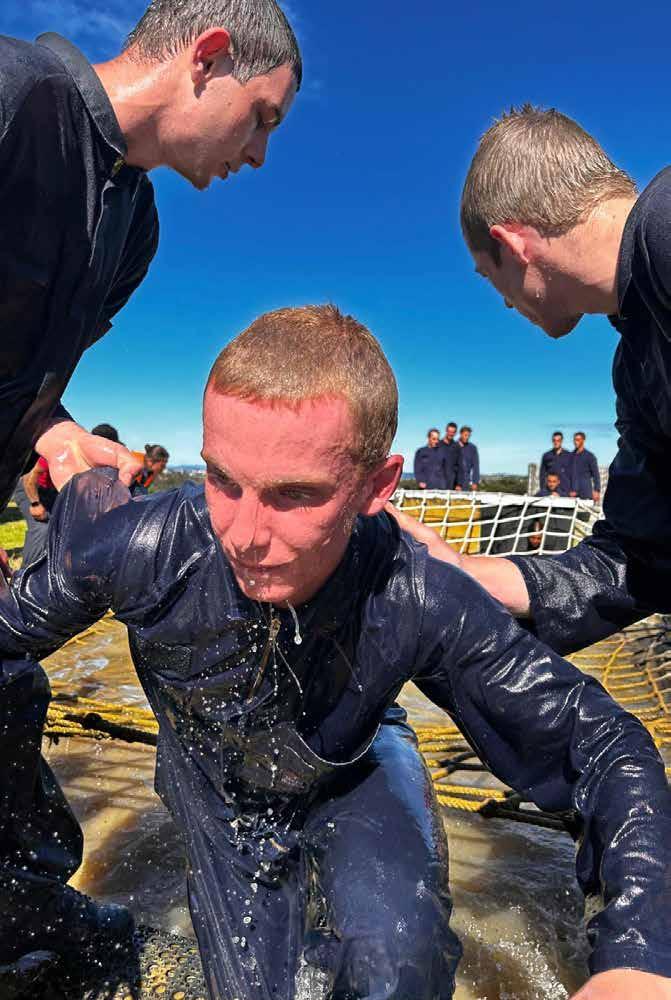
It’s an early Monday morning start for Basic Common Training intake 24/01 at the beginning of Week 5 of their training, and 79 trainees are boarding buses with little to no idea of what’s coming up.
The staff can see that they’re nervous but they’re not about to enlighten them just yet as to what they have in store for them. Week 5 is marked in the training programme as BLOC Week (Basic Level of Capability), previously known as ‘Shakedown Week’. It’s about lead-self, endurance, resilience and hopefully a lot of smiles at the end of it.
It’s not as if the trainees are getting thrown into the deep end after four weeks of sitting in a classroom. They’ve already trod water in the deep end – literally. They’ve ironed, folded and polished their kit, they’ve cleaned their mess decks from top to bottom. They’ve pushed hard in the Fleet Gym. They’ve paraded, marched, stood at attention, listened to instructions, moved with urgency. They’ve adapted to their new environment on base and are learning teamwork. And yes, there’s also been plenty of classroom learning. The BLOC Week, held up at Tamaki Leadership Centre (TLC) at the extreme end of Whangaparāoa Peninsula, is about the culmination of what the trainees have learned during those first four weeks. During their week at TLC, an isolated setting with plenty of room to move, the trainees face tests of endurance, including the confidence course, firefighting drills and leadership exercises. The days are long, notably ‘the longest day’, which could involve being active for 18 hours.
What the instructors are wanting to see is how the trainees function at their highest and lowest points. They want to see resilience combined with teamwork – essentials for a sailor at sea.


Chief
Weapon Technician Dwayne Williams, Leander Divisional Chief, says the aim is to build on the elements of ‘Lead Self’ learnt in the first four weeks of training and align the trainees’ behaviour and performance with the expectations of the New Zealand Defence Force.
“BLOC is a surprise for them, and they don’t know what’s coming unless they’ve spoken to someone prior to starting their training. So naturally, there are some nerves heading into the week.”
The week’s programme has been pre-planned but there are always ‘surprises’ from the Instructors, who have lots of tools in their tool box, he says.
“During the planned events the Instructors won’t actively encourage the trainees. It’s their classmates, their oppos, who push them through and lift them up. We also have peer-to-peer feedback sessions throughout the week, an opportunity for trainees to hash things out in a controlled environment, and they get really lifted by it. People might get called out for things they are not aware of, while people get applauded for achievements. Someone who had been struggling physically may get praised for really pushing themselves, for really digging in.”
And there’s the teamwork element. Every intake has trainees who are already extremely fit. “You have people who are clearly physically capable, just going through the motions and finishing an event. Are they jogging back down the road to push others along? Are they thinking about the collective? Because the group is only as fast as their slowest person.”
You see the best moments during the Longest Day, he says. “They start in high spirts and push through the low points. It’s when they reach that final part of the day, knowing they might be heading to bed soon. During their final ‘reflection’ that night, they still had the energy to sing for the staff. They performed well and some of them surprised themselves.
“They might have been nervous at the start, but they’re all smiling at the end of it.”


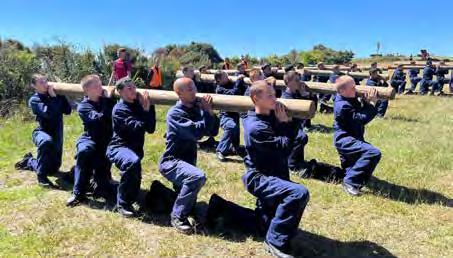
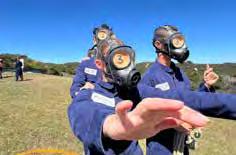


“I have a passion for problem solving, getting my hands dirty, pulling things apart and fixing them. When I was growing up I wanted to be like my Dad – he was an MT(L) as well. I also grew a deep love for the ocean. So it was a given that I would join the Navy as a Marine Technician.
“I joined the Navy in 2020 and I’ve been posted on board HMNZS MANAWANUI since May 2023. My day starts with a morning meeting with my team, we talk about the goals for the day. We then split into our parts of ship within the trade. I am ME04 which is the Electrical part of ship. Working alongside my Leading Hand, other Able Rates and Ordinary Rates we start completing jobs on our FMMS list. FMMS are our planned and breakdown equipment maintenance jobs, making sure all our machinery is safe and well maintained.
“I have had a lot of really proud moments over my Navy career. One recently was being able to help in the remote Fiji Islands with disaster relief after the cyclone last year. I got to meet so many special people, it really was a once in a lifetime opportunity.
I have had a lot of really proud moments over my Navy career.”
“My former head of Maritime Engineering School, Lieutenant Commander Clare Talbot, is the Marine Engineer on board. She has had a huge impact on my journey. I just thought it was so inspiring that a woman could be in that position as Head of School and it gave me a lot of faith that I could be successful too one day. Clare has also been supporting me through my training in MANAWANUI and pushing me to complete my task book. It has been amazing having her as our Engineer onboard as she offers so much to the team and someone I can always talk to.
“I’d like to see the Navy creating strong support systems, especially for people like myself in a Tech trade. It is extremely male dominated – which is absolutely fine – but it can feel really lonely and isolating sometimes.”

LHST Blenkarne says it is inspiring seeing confident women in the Navy, which helps others step forward. She tells her story:
“I joined in 2018 to do something different that I could look back on and be proud of.
“I’m the Navigation Assistant in HMNZS MANAWANUI. My day varies between Navigation system updates, seaboat coxswain duties, watchkeeping and other auxiliary things that I do on board.
“I am from Auckland, so I consider myself lucky to still be able to see my family regularly. My interests include getting outdoors and spending time with my family and friends.
“An achievement that I am proud of was getting recognised for my coxswain duties on board MANAWANUI. There was a period of time that I was the only qualified boat coxswain on board. It gave me a massive sense of pride to be able to conduct not only my primary job but also the job of coxswain to a high standard.
“The Navy’s investment in women means we see more females with confidence in their roles due to more support from other females in a higher position. This has led to seeing more females willing to put their hand up for things that they may have typically in the past not have done, due to it being more male orientated.
“The Engineering Officer on-board MANAWANUI, Lieutenant Commander Clare Talbot, has inspired me since I have posted here. It’s inspiring and empowering to see a woman in a heavily male-dominated trade or role. The way she delivers the needs of the department while also having a wealth of knowledge behind her shows younger sailors like myself that it is possible to work your way up through the ranks while in a male-dominated trade. She also advocates for the females on-board and encourages us to go further.
“For the future, I would like to see more investment into women’s health and awareness around women’s health both physical and mental.”
I am proud of getting recognised for my coxswain duties on board MANAWANUI. There was a period of time that I was the only qualified boat coxswain on board.”

“I was born in England as my Dad was in the Royal Navy but we moved to Auckland when I was seven.
“I joined the Navy in 2022 to do something new that would challenge me and be something that would allow me continually learn.
“As the AMLO in MANAWANUI, my day varies depending on what the ship is doing but I’m currently beginning the planning cycle for our next deployment. This starts in a few weeks and involves looking into all the logistical considerations for the duration of the deployment.
“I’ve come into a Navy that has females in senior leadership or positions of power and influence, which provides a benchmark to work towards and lets new, younger females know that they will be able to progress their careers any way they want.
“I think the Navy has opened a lot more doors for females, providing them with the confidence to put their names forward to do things that may have originally been male-dominated in the past.
“There are so many females that have inspired me in my short time in the Navy. Significantly, Commander Paula Dacey, who is the Commanding Officer Leadership Development Group. She is a wealth of knowledge in relation to our trade, but also approachable, supportive and inspiring. Though I
wasn’t in attendance when she took command, it was noted that her speech drew on the themes of being a small female who can be overlooked or underestimated but essentially, do not judge a book by its cover. I find that so powerful and empowering as a young female officer wanting to essentially follow in her footsteps.
“There is also our own Commanding Officer of MANAWANUI, Commander Yvonne Gray. She is another strong female who has shared some of her journey with us, who had to overcome a lot of challenges being a female in a time when the Navy was still very much made for men. Even now it is still surprising among a lot of people outside the Navy that the Captain of a ship can be a female and while it has become commonplace for us, I think it is something we shouldn’t take for granted and we should admire the work that went in to get there in the first place. She shows the young sailors on board that it is possible to work your way through the ranks in a role that was so male-dominated in the past. She advocated for the females on board and encourages us to push and challenge ourselves to make the most of our career.
“For the future I would like to see more investment into Woman’s Health. Although again it has come a long way, there is still a lot more that can be done.
“Additionally, looking into career progression while having children is something that can be worked on more. It’s a subject talked about by a lot of young females who are wanting to have families in the future but feel like that would impact their career, as it means they can’t go to sea or get put in a position that prevents them from progressing.”
1. CDRE Mat Williams checks the name on the side of the NZ Operational Service Medal, presented to newly-promoted CDR Linda Bruce.
2. Commanding Officer Maritime Training Group CDR Andy Dowling meets his UK counterpart, Commanding Officer Fleet Operational Safety Training team CDR Tim Leeder RN, following the Deployable Boarding Team’s work with HMS TAMAR.
3. Deput y Chief of Navy, RADM Jonathan Earley RAN presents ENS Brooke Williams with a certificate of participation during the Western Pacific Naval Symposium Junior Officer Interaction Programme at Russell Offices, Canberra.
4. LHLM Michael Fraser and LHLM Tyson Turnbull, No. 6 Squadron, in front of their Seasprite SH-2G(I) helicopter during Warbirds over Wanaka.
5. Quinn Quinlan, based at Defence Logistics Command (Maritime), is promoted to Lieutenant Commander, with Commander Logistics CDRE Maxine Lawes doing the honours.
6. Former World War II WRNZNS veteran Norma Bucknell celebrates her 102nd birthday at her rest home in Auckland, joined by CDR Julie Simpkins, Commanding Officer HMNZS PHILOMEL.
7. The Easter Bunny visits CAPT Lisa Hunn at the Fleet Personnel and Training Organisation.
8. The Fleet Flight Deck Officer, Chief Petty Officer Master-AtArms Nicole Mattsen, during HMNZS CANTERBURY’s SARC (Aviation).
9 From left, OMT Kael Marsh, OCSS Flynn Wilson and OET Brandon Sheat, Leander Division BCT 24/01, enjoy a Church Service with members of the South Pacific Community.
10. Defence Minister Judith Collins poses with naval personnel for International Women’s Day. From left, CDRE Maxine Lawes, SLT Alana Ibbs, CDR Ange Holland and LT Jen Fellows.
11. Seamus Shaw is promoted to Lieutenant Commander at Defence House, with his son Xavier (with some help from Deputy Chief of Navy CDRE Andrew Brown) revealing the new rank slides.
12. BCT 24/01 trainees, from left, OMT Joao Paulo de Mattos e Avila, OMT Timothy Bosman, OCT Ling Wingate, OHSO Bede Kane, OCT Liam Khamal and OMT Connor Davenport.

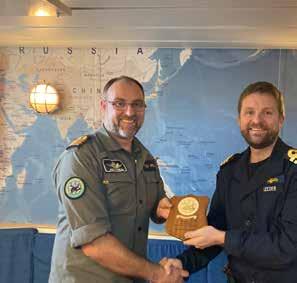








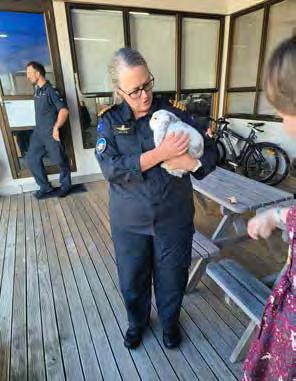




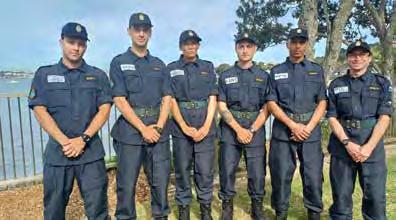
A former Navy Communications specialist who left to co-found an IT software start-up is now bringing his computer skills back as a Communications and Information Warfare officer.
Lieutenant Jayden Bartram, 32, originally from Christchurch, says he left Riccarton High School to become a chef, while applying for both the NZ Police and Royal New Zealand Navy. It was 2011, with the city recovering from the earthquakes that year, and making a career somewhere else was attractive.
His initial stint in the Navy (2012–2016) included Operation Tiki VI on board HMNZS TE MANA, conducting antipiracy patrols in the Gulf of Aden and Arabian Sea and Exercise Southern Katipo on board HMNZS MANAWANUI.
He reached Leading Hand rank and felt it was time to leave and gain further experience in the private sector. Staying on in the Navy Reserve Forces, he returned to Christchurch and obtained diplomas in Computer Networking, Business and a Certificate in Science and Technology. Following a stint as a Senior Enterprise Network Engineer for 2degrees, he became Head of Product and Software Engineering for a company in Auckland before co-founding software business Couchdrop Limited.
The business, specialising in secure electronic data transfer, achieved an international profile with most of its business conducted in North America and Europe. LT Bartram co-led the business for over five years as Chief Executive and then transitioned to Chief Operating Officer prior to departing the business, which employs 15 people internationally.
“The company is still going strong”, he says. “But I wanted more purpose for a career. I was a reservist with HMNZS PEGASUS and that had kept the door open, but coming back to the Navy fulltime as a Leading Hand wasn’t where I saw I could apply my skillset and make a positive impact. I wanted to use my experience, thinking and skills in a different capacity.”
He undertook the new Naval Reserve Common Training programme part time over 18 months, commissioning from the ranks in April 2023. “The positive aspect was making good connections. In reserves, everyone has other careers and it’s about building your networks.”
He transitioned out of his business, rejoining the Navy full-time in October as a General List Operations Support Communication and Information Warfare officer (GLOSPT (C)).
Officers in this trade are responsible for leading the development in support of military effects from communication and information warfare-related capabilities throughout the full spectrum of conflict.
They oversee all Communications and Information Warfare (CIW) related capabilities so that they can be integrated, synchronised and delivered to meet mission objectives.
He’s now on an Information Warfare Officer course in Australia and working on a Bachelor of Arts through Massey University, majoring in Security Studies.
“I don’t think I could have timed this any better,” he says.
I’m bringing my IT experience, communications background and leadership skills from running a company. I’ve come from a field where you need to understand how businesses and people use data, and how marketing influences people and decision-makers. Being able to apply my experience and skillsets into a technological area is very rewarding.”
– LT Jayden Bartram
“What comes next? That’s a great question. This is a whole new world. I like being part of something new and growing it. It just shows how important it is for you to maintain your connections when you leave. I’m excited to be back in and see where my career goes.”
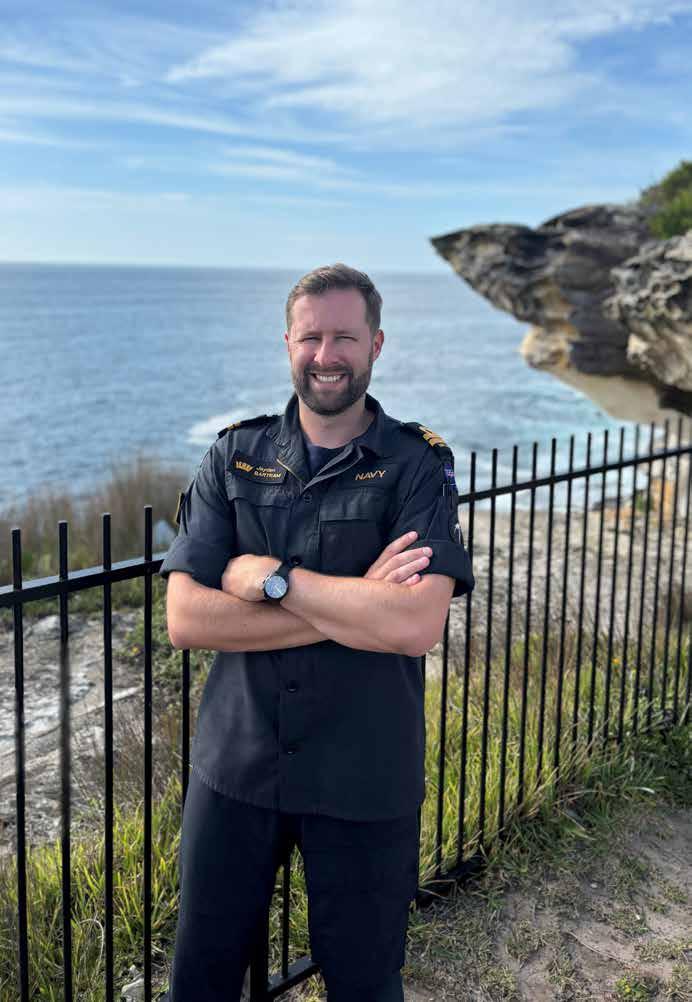
University
Alexander Simons says his Naval Reserve duties have definitely brought him out of his comfort zone.
Ordinary Maritime Trade Operator (OMTO) Simons, from Mt Roskill, Auckland, has been based at reserve unit HMNZS NGAPONA since graduating from the newly established Naval Reserve Common Training course in 2022.
MTO personnel provide the interface between the maritime industries and the New Zealand Defence Force, both ashore and at sea, in support of humanitarian and warfighting operations. It’s their role to brief merchant vessel masters on known security threats and military operations that might impact on their passage, and debrief masters to collect information on security and threat issues they might have seen.
OMTO Simons is in the middle of a four-year degree, studying electrical and electronic engineering at the University of Auckland.
He says he’s been interested in the military since he was a young age. At age 11, he got to tour museum ship USS MIDWAY in San Diego, which made a big impression on him. In his free time he enjoys reading about current naval affairs and technology.
“I’m doing my reserve hours on top of my study,” he says.
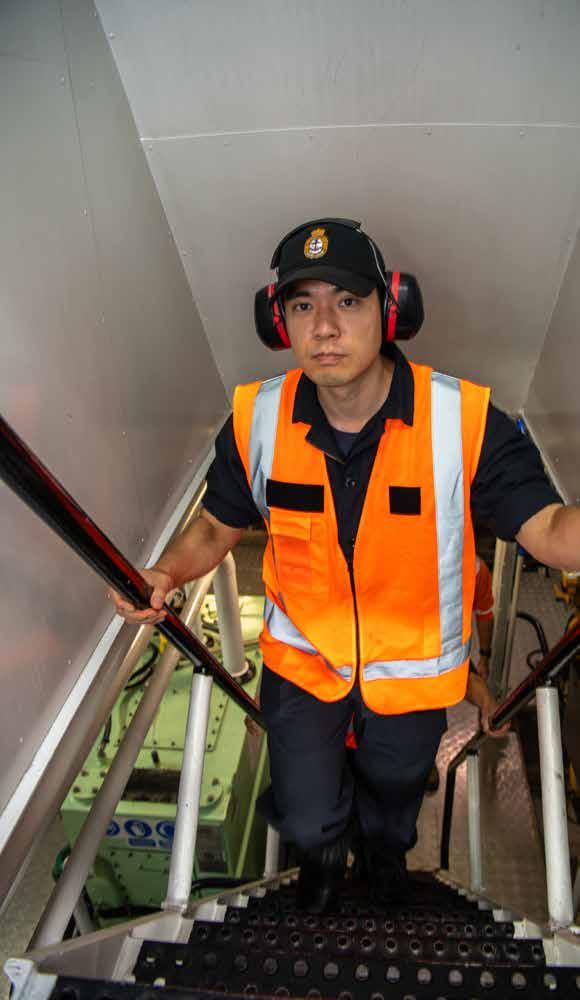
There’s a lot to offer you, and a lot of opportunities that come with it that you wouldn’t find elsewhere. I would tell anyone thinking about it to do some research and give it a try. There’s a lot of value in it.”
– OMTO Simons
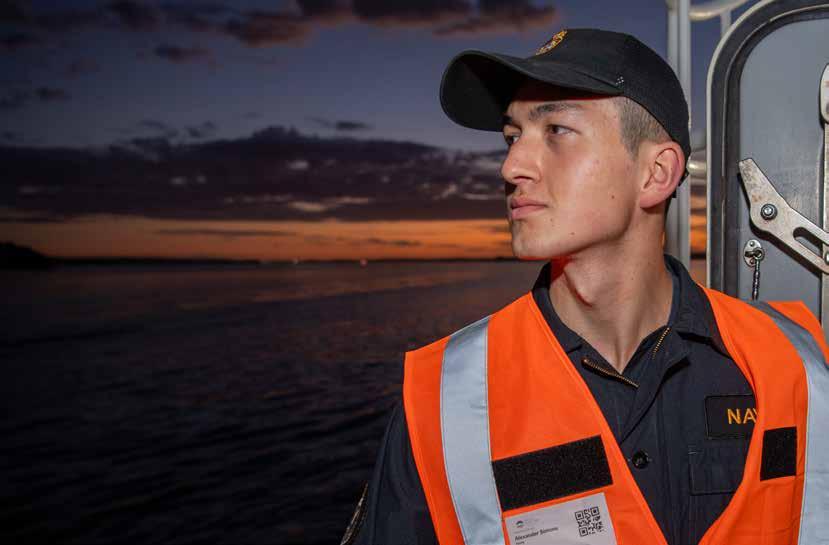
“It’s training on Wednesday nights and a couple weekends, with a few long stints of training for one or two weeks. What I’ve found is that the planning of dates was really good. The initial long period of training was during my semester break, which was convenient. And if I’ve got an exam on the same day, I can get leave from the Wednesday nights pretty easily.
“What this training has definitely done is brought me out of my comfort zone. We stay up at the Tamaki Leadership Centre in Whangaparāoa for the 10 days of initial training. There’s a lot of camaraderie that comes out of that, which is something I hadn’t experienced before. On my course there was another person doing engineering at the same stage as me, and that’s become a really good friendship.”
He’s the first one in his family to get involved in the military. “There’s a lot to offer you, and a lot of opportunities that come with it that you wouldn’t find elsewhere. I would tell anyone thinking about it to do some research and give it a try. There’s a lot of value in it.”
He’s aware his field of study is sought after by the Navy. “It’s something I’m considering for the future, but for the time being I definitely want to stay in Reserves. I’m enjoying being with NGAPONA and I’ve got time to make up my mind on that.”


If you want something done, give it to a busy man.
You can hear a touch of rueful humour when Lieutenant Commander Greg Liddy says those words. But you also get the impression that’s exactly the way he likes it.
LTCDR Liddy is Waikato’s newest Regional Naval Officer, appointed during the middle of last year.
He comes to the role off the back of a 26-year career with Air New Zealand, as an international pilot and senior fleet manager. His naval role is only one of numerous duties to a variety of trust boards and organisations across Waikato.
He joined the Navy as a reservist at age 18, at a time when the ‘black boats’ – the Harbour Defence Motor Launches – were sailing up and down the country. “I was at Victoria University doing my degree and it meant a bit of cash. I didn’t want to go into the Army Reserves and sleep in a tent in Waiouru!
“I had a deployment in HMNZS OTAGO in 1979 for six months, including the RIMPAC exercise in Hawaii and on to the United States. I thought, this was the best thing ever, so I joined full time.”
He gained his watchkeeping certificate and later specialized in aviation, heading to the United Kingdom for three years to fly Sea King helicopters off carriers HM Ships ILLUSTRIOUS and INVINCIBLE. “I returned home had a tour with 3 Squadron Wasp flight and then I switched to the Inshore Patrol Craft, taking command of HMNZS ROTOITI – the old Lake-class patrol boats – and sailing these around the coast of New Zealand doing fishery patrols, Customs and Police engagement.”
Seen today, a jump from aviation to commanding patrol craft seems odd, but that was the usual thing, he says.
“Back then, you couldn’t join as a pilot. You joined as a General List Executive Officer. You would do two to three years of aviation, then you did other jobs, like patrol boats. Then you’d go to HMNZS TAMAKI to teach.”
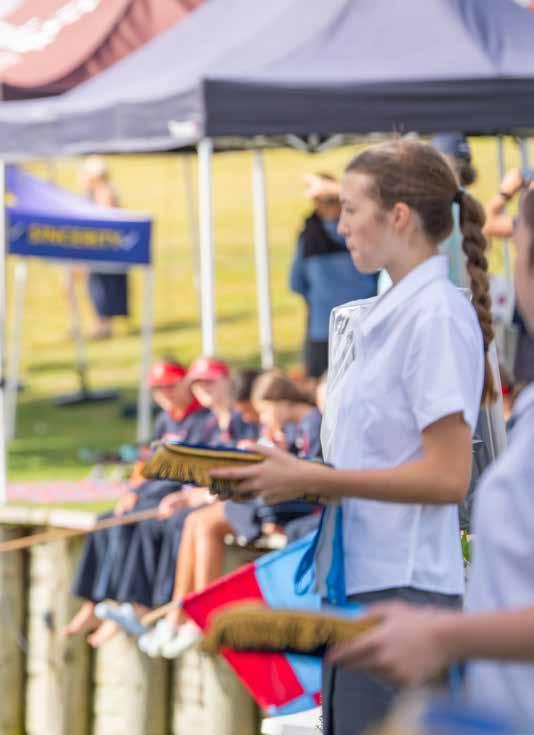
He notes that he was the first Divisional Officer to a lot of very senior people in the Navy today.
He obtained his fixed-wing licences and became a pilot with Air New Zealand. “That passion for aviation was still present. I went on to see some tumultuous change in Air New Zealand, from a small localized carrier to a carrier with a strategic plan to cover the rim of the Pacific.” He managed all the fleets in Air New Zealand during his tenure and in his last role, as senior fleet manager Boeing 777, he had strategic responsibility for over 300 pilots and 16 aircraft – including placing the aircraft into long term storage during the Covid pandemic.
He’s the first Regional Naval Officer in Waikato for some time.
“Commander Clive Holmes (RNO Canterbury) asked if I would consider it. We’d joined up together and been
rattling around the same parts of the world together. I thought it was time to give back. I’m the person I am because of what the Navy did for me, and I used a lot of Navy experience in the corporate world. It’s that divisional system and your training, it’s time management and communication skills. When I was 22 I had my own division and was managing them and coaching through life in the Navy. Young officers are taught to engage and they have a sense of structure. It’s easy to underestimate how useful these skills are in your career.”
CDR Liddy is always looking for ways to advocate for the Defence Force in his area.
“Councils have been particularly favourable,” he says. “The five mayors are interested in what I do. The harbour masters are particularly interested in how we can assist them. And the
People come and talk to you when you’re in uniform and I’m always looking for any opportunities between business and defence.”
– LTCDR Greg Liddy
LTCDR Greg Liddy representing the Navy at the North Island Rowing Championships.
businesses are keen to work with me. I talk to the Chamber of Commerce, I attend the Waikato Business Awards. People come and talk to you when you’re in uniform and I’m always looking for any opportunities between business and defence.
“There’s also the traditional stuff, helping recruiting, making presentations, and being involved with the Cadet Force in Waikato.”
Add in his board directorships, developing an E-Waste Recycling opportunity and the Chief Safety Officer role at Karapiro Rowing, it sounds like a lot for someone who’s retired.
“Retired from full-time paid employment,” he says. “But you keep busy. And’s it about giving back. That’s what I can do.”
It’s well and good that ships and their crews can meet the requirements of their Standard Operating Procedures.
It’s something that is tested all the time. But in an evolving maritime landscape, are the procedures in need of change, and how do we devise completely new ones when some flash new gear comes along?
It’s the job of the Operational Performance Analysis Unit (OPAU) to consider the changing operational environment as they assess the efficiency, effectiveness and overall capability of the Royal New Zealand Navy’s operations.
The unit, stood up about three years ago, consists of a Staff Officer (Commander Muzz Kennett) two civilians and three uniformed personnel. The team works alongside personnel of the Directorate of Sea Power & Warfare (DSP&W) and Maritime Training Group (MTG).
They could literally test anything, but their focus at the moment is on the Naval Combat Force. It’s MTG’s job to hold ships and their crews to a standard. But OPAU asks the question, is that standard still fit for purpose, and what brandnew standards do we need?
Team member Johnnie Brooke says they will look at hardware, software, operational organisations, tactics, drills and procedures. “And any other testable matter that can affect operational effectiveness or suitability for use in an operational environment.
“The goal is to optimise naval activities, identify areas for improvement, and enhance the overall operational effectiveness of the naval forces through data-driven decision-making.”
“Our operational testing (OPTESTs) could focus on a particular warfare area. There’s data gathering, record keeping and analysis from naval exercises, specific serials, real-time mission feedback and coordinated use of several systems to achieve a tactical or operational goal. It could go up to the level of a Task Group operating in a Task Force.”
The Unit will decipher patterns, identify strengths and make recommendations to rectify weaknesses.
“It could happen over several exercises, or even over a period of years. There are Standing OPTESTs which continue throughout a system’s service.”
The biggest evolution in recent years has been the Frigate Systems Upgrade, with brand-new operating procedures to be developed. The firing of the Sea Ceptor missiles from HMNZS TE MANA last year is a good example.
“Simply put, can the missile do what it says on the box? The firings proved TE MANA could protect itself and protect another ship. But what is the best way to do it? What’s the best place to position ourselves? Is there a better way to defend? We assess how effective the tool is, we’ll provide the analysis, and the client will make their conclusions.”
The team sees themselves not just an analysts, but influencers of future naval strategy. Commander Kennett says they leverage cuttingedge technology and software from the wider allied community.
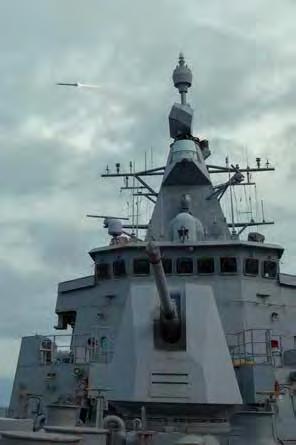
“Ship signature analysis and weapon performance analysis will also be a key focus area for the team. The OPAU is committed to collaborating with wider New Zealand Defence Force, Defence Science and Technology, allied naval research institutions and Five Eyes operational analysis teams, engaging in joint exercises with allied forces, and harnessing the power of simulation technologies.”
“Future work will go beyond simple data and statistics. We’ll play a pivotal role in assisting the refining of doctrine and tactics. It’s not only fortifying our defence capabilities, but harnessing innovation in offensive manoeuvres, pushing the boundaries of maritime excellence.”
Above: The firing of a Sea Ceptor missile (top left of photo) from HMNZS TE MANA in December opens up a new field of analysis and data gathering for the Navy’s Operational Performance Analysis Unit.

From November 2023 until February 2024
I
had the incredible opportunity to embark on a secondment with the US Navy Pacific Fleet Headquarters Team located on the Island of Oahu, Hawaii.
For context, the US Navy Pacific Fleet area of responsibility covers approximately 51 percent of the earth’s surface, It encompasses the Pacific Ocean and spans from the West Coast of the United States to the eastern boarder of the Indian Ocean – or what is commonly referred to as, from Hollywood to Bollywood, and polar bears to penguins. The area contains half of the world’s population, 58 percent of the world’s youth, 60 percent of global GDP, two-thirds of global economic growth, 65 percent of the world’s oceans and 25 percent of its land.
As a senior enlisted sailor proudly representing the Royal New Zealand Navy, this experience was nothing short of exhilarating.
Navigating the vast waters of collaboration, I found myself immersed in a dynamic environment where shared goals and mutual respect formed the compass guiding our efforts. Working side by side with the US Navy personnel, I was struck by the unwavering dedication and professionalism that defines the sailors of both nations.
One of the most enriching aspects of this secondment was the exchange of maritime expertise. The intricate details of naval operations were shared freely, fostering a culture of learning, growth and community. We shared new perspectives on strategies to improve conditions of service, recruiting and retention initiatives, educational opportunities, family support services, professional military development opportunities, and building a connected and inclusive naval community.
Beyond the professional realm, the cultural exchange was equally rewarding. The US Navy Pacific Fleet Headquarters Team graciously welcomed me into their tight-knit community, showcasing the unique traditions and values that make our naval forces distinct yet interconnected. It was a reminder that, no matter our origins, sailors share a common bond forged by the sea.
This shared experience will undoubtedly strengthen the interoperability between our navies, enhancing our collective capabilities in the ever-evolving maritime landscape. This collaboration serves as a testament to the power of international partnerships in maintaining maritime security and stability.
I’m grateful for the opportunity!
He heramana ahau.

Lieutenant George Sinclair says anyone with a “problem-solving mindset” should consider an engineering role in the New Zealand Defence Force.
LT Sinclair is on exchange with the Royal Australian Navy, posted to Auxiliary Oiler Replenishment ship HMAS STALWART since July 2023.
Following an engineering course at HMAS CERBERBUS near Melbourne, LT Sinclair is conducting his Assistant Weapons Engineering Officer (AWEO) on-job training aboard STALWART. It’s part of his journey towards becoming a Deputy Head of Department and ultimately the Weapons Engineering Officer in a Royal New Zealand Navy Anzac-class frigate.
“My job in STALWART is to assist the Deputy Weapons Engineering Officer with the daily running of the Weapons Engineering Department, which involves 25 people who maintain the weapons, communications and sensor systems,” he says.
Originally from Whakatāne, his Navy journey started in 2009, joining as an Electronics Technician and changing to Weapons Technician when he was promoted to Leading Hand. He retrained as an officer, commissioning from the ranks in 2020.

“I wasn’t interested in a student loan, so I decided to join the Navy. I thought I would join for five years, but that changed once I experienced the work and travel. I found myself embedded in a community of good people from all over New Zealand.”
Highlights of this exchange has been the strong friendships he has formed through his training journey.
“It’s good to be back in the sea lanes. I’ve been part of a regional presence deployment to Asia, visiting interesting places like Japan and South Korea. .It’s amazing how peaceful a large city like Fukuoka can be when there is minimal cars on the road and people actually wait for the pedestrian lights to go green before crossing the road.”
He says it’s fun learning about a new Navy, and interesting to see the comparisons.
“As a Weapons Engineer it’s like visiting the toy store as a kid with no money to buy anything. The Royal Australian Navy are playing with some of the next
generation weapon systems, due to their close relationship with the United States. These weapons are not fitted to our vessels back home.
“But in other ways we’re very similar. Both Navies are going through a personnel regeneration period, due to retention issues over the last decade. When listening to the reasons, it’s like listening to my mates back home.
“One other thing is no moustaches or long hair is permitted for personnel in the Royal Australian Navy. Naturally I am the recipient of many compliments and praise for my moustache!”
His goals are to represent the Royal New Zealand Navy well and achieve his Weapons Engineering Certificate of Competency to a high standard.
“Then I’ll return to New Zealand in October, and hopefully post to one of the frigates for my Deputy Weapons Engineering Officer time.”
It’s fun learning about a new Navy, and interesting to see the comparisons.”
– LT George Sinclair

The long running ‘Long Time No Sea’ reunions in Australia have come to a worthy conclusion, with the finale hosted in Canberra over Easter.
The reunions evolved from a get-together in 2005 between former Royal New Zealand Navy sailors based in Australia.
Two sailors, George McGarvey, and Kelvin Kershaw, having ventured to Australia after serving their respective “sea time” in the Navy, decided it was a great idea to renew their acquaintance once again by arranging a get together.
Central to their cause was Alice Springs as George, with mates Rob Kopa, Tu Ngatai, Rob Simpkins and Otene Reweti were living some distance south of Alice Springs and Kelvin was in Broome. So, in 2005 the first hosting city chosen was Alice Springs.
The attendance in Alice Springs attendance of 45, although small, was the beginning of bigger things.
In Alice Springs a Steering Committee consisting of George and Kelvin was formed to guide the processes necessary to ensure the success of each future Reunion.
It was declared that in each preceding two years a new host city would be chosen, a committee elected to arrange the proceedings, and a host hotel would be selected from options available.
These Reunions would be called the Long Time No Sea Reunion.
The LTNS Reunions over the years have evolved from predominantly Australianbased RNZN personnel, domiciled, retired, or still serving, to more than an equal share of New Zealandbased personnel “crossing the ditch” to attend, who share and restore their camaraderie and goodwill complemented by the “odd” tall story being stretched at each Reunion.
The programme format, two years in the making, arranged by a volunteer committee, has always included a Powhiri, Meet and Greet, Memorial visit, wreath laying and march, RSL visit, local tour spot visits and a Formal Dinner included in the four-day programme.
This in turn has boosted the revenue in the selected hotel, where all attendees must stay according to the rules attached to the LTNS Reunion format.
Since 2005 there have been another seven Australian cities where the LTNS Reunion has been held and two others cancelled due to COVID restrictions.
The venues have been: 2007 Perth WA, 2009 Sydney NSW, 2011 Gold Coast QLD, 2013 Melbourne VIC, 2015 Adelaide SA, 2017 Broome WA and 2019 Hobart TAS.
The 2021 Canberra event was cancelled due to COVID restrictions.
This year, a Long Time No Sea Reunion Finale was held in Canberra, with 117 personnel registered to attend over the during the Easter Weekend break.
It was called a finale because over time the regular attendees have naturally aged. Retirement and the world economy has meant travel costs and budgets are not so easily met, plus the inevitable Crossing the Bar has dwindled the numbers.
However, this will mean that the Steering Committee will have achieved their original objective to host a LTNS Reunion in every State and Territory in Australia – a great milestone!
This does not mean the end of RNZN Reunions as these are still ongoing events held frequently, more so in New Zealand now, which allow the continuation of non-retired, retired and currently serving members of the RNZN to gather and continue what the RNZN family has fostered over the years – fun, fraternity and friendship.
A sailor with an afterhours Devonport mowing business is chasing as much work as he can to support a friend with cancer.
Able Electronic Technician Marek Schirnack, who has operated Mazza’s Mowing since October 2023, is donating all his mowing earnings apart from business costs to support his best mate’s partner, diagnosed with lung cancer earlier this year.
“I got this devastating call from Luke, telling me his partner Poppy had been feeling a bit off. She’d gone to the doctors and an x-ray showed a cancerous tumour in her lung, three inches in diameter. At the age of 23 and as a non-smoker, this came as a huge blow to her.”
Poppy is from the United Kingdom and on a working visa. The pair were worried her treatment wouldn’t be funded in New Zealand.
“I knew I couldn’t sit back and do nothing, and reckoned my mowing business would become my avenue for bringing in some fundraising.”
He posted on Devonport community social media, describing himself, being in the Navy, and the situation his friends were facing. He offered his mowing services to the wider community.
“Prior to this my clientele had been predominantly other sailors. In my post, I proposed to donate all of my mowing earnings to the cause outside of the running costs of the business.”
AET Schirnack says he was flooded with messages for work and people keen to donate to the Give-a-Little page the friends had set up.
“Luke organised a charity auction and rugby game in Taranaki and a lot of people, businesses and sports teams donated items into that. We raised $14,000 for Poppy, and Mazza’s Mowing was able to contribute a good chunk of money towards it.”
He says that have now found out that Poppy’s treatment will be largely funded. “We’ve been told the tumour
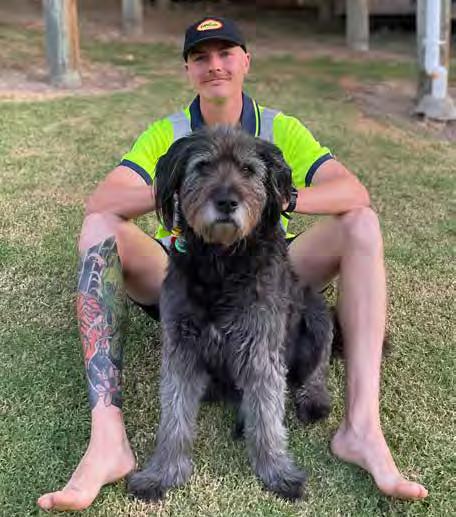
hasn’t spread to her liver, which gives her a much higher survival rate.”
The remaining money will be used for ongoing costs towards her treatment.
AET Schirnack wants to keep contributing.
“I’ve decided to keep donating a portion of my earnings to Poppy’s cause. She’s a fantastic person who does a lot for people, so this has been an easy choice.
“I’m offering my services to any locals requiring one-off or regular mowing. I feel I charge fairly reasonable rates, and offer estimates based on size of lawn. I also offered a discounted rate for elderly and single parents, figuring I could give something back to the community that adopted me when I joined the Navy.”
Luke Fleming, Poppy’s partner, posted on social media to say he was deeply appreciative to AET Schirnack and everyone who had donated so far.
“Cancer is a scary time and with myself having to take a lot of leave from work to get her to and from appointments and Poppy being basically unfit for work the financial strain has been a bit of a headache.”

AET Schirnack says Navy commitments means he can only get out in late afternoons or weekends.
“I try to get round to all my regular clients on a pre-arranged basis and give them a mow they can be proud of.
“I figure at the end of the day, every little bit of free time I have and can use will go a long way to help Poppy.”
There’s no doubt he has the energy. AET Schirnack featured in Navy Today December 2021 after breaking the Navy record for the Multi Sport Fitness Test, better known as the ‘beep test’, achieving the first level 17 run in Royal New Zealand Navy history. There appears to be no official world record table, but his achievement is listed on www.topendsports. com as first equal in their list of World’s Best Beep Test Scores.
HMNZS PEGASUS personnel walked in the footsteps of their forebears at the centenary of the Banks Peninsula war memorial in Akaroa on March 10.
Officers and crew of HMS CHATHAM, a light cruiser lent to New Zealand Naval Forces in 1920, attended the memorial’s unveiling on a very wet day in 1924. It was a far cry from the cloudless skies and near 30 degrees that greeted PEGASUS personnel and others at the centenary commemoration, which largely followed the original service’s format.
Christchurch architect Henry St Aubyn Murray designed the memorial, made of Hoon Hay basalt, Glentunnel stone, Aberdeen pearl granite and Oamaru limestone. Minister of Defence and local MP Sir Heaton Rhodes unveiled the memorial on 12 March.
PEGASUS Commanding Officer
Lieutenant Commander Rob Hall said the event was particularly poignant in the lead up to Anzac Day, and noted that CHATHAM now lends its name to the RNZN’s Chatham scheme for University student recruits.
Banks Peninsula RSA president Jim Coubrough told the centenary service the local community, like many others at the time, grappled with how to best commemorate the fallen. A committee was formed to raise money and determine the design.
“There were strong emotions and a wide variety of interests to be represented. It has been said that the influence of the French settlers led to a design which supposedly evokes the Gothic buttresses of French cathedrals to try and recognise the feelings between the British and the French.”

He said the foundation represented the community the fallen came from, and the four buttresses how they came together to serve in one purpose, with the spire and crosses symbolising the sacrifice they made.
Today, the memorial is overseen by the Banks Peninsula War Memorial Society. Incorporated in 1919, it is one of the oldest existing groups in the Akaroa area, and the Society is determined to retain the memorial and grounds in private ownership.
Society chairman Hamish Craw said the memorial had been a community one from the very beginning.
“Four of our local Banks Peninsula Councils – Akaroa Borough, Akaroa County, Mount Herbert County and Wairewa County all provided financial support, particularly with the ongoing maintenance of the grounds”.
The community’s Anzac Day collection goes towards its maintenance, and close to $1m was raised to repair and strengthen the memorial following the Canterbury earthquakes.

The handheld image shows the Memorial opening in 1924, with sailors from HMS CHATHAM.
Credit: Jesse Buckland / Akaroa Museum
Former HMNZS GAMBIA sailor Ray Goddard celebrated his 100th birthday on March 16, surrounded by family and friends at his home in Taupō.
Regional Naval Officer Lieutenant Commander John Smith presented Mr Goddard with a letter and a challenge coin from Chief of Navy Rear Admiral David Proctor.
Born in Raetihi in 1924, Mr Goddard joined the 8th Army Service Corps New Zealand Army on June 25, 1942 but then enlisted in the Royal New Zealand Navy on July 27, 1943.
He served on HMS SAUNDERS in Egypt, HMS ASSEGAI at Durban, South Africa, HMS LANKA at Ceylon, and HMNZS GAMBIA (June 1944–10 January 1946).
He was a member of HMNZS GAMBIA’s “B” turret gun crew who were shelling Japanese shore positions when the ceasefire was announced on August 15, 1945.
GAMBIA is famously reputed to have fired the last shots of the war on that same day when a lone Japanese fighter made a kamikaze run for nearby carrier HMS INDEFATIGABLE. The fighter veered towards GAMBIA but was shot down by a US fighter pilot in a Corsair.
It is also possible crewmen of GAMBIA, including Mr Goddard, were the first allied personnel to set foot on Japanese soil. On August 20 Royal Marines and sailors from GAMBIA took the surrender of the Japanese Naval Base at Yokosuka. The crew were photographed with a captured flag from the base.
GAMBIA would later go on to represent the Royal New Zealand Navy in Tokyo Bay on 2 September 1945, when the Japanese signed the instrument of surrender on board USS MISSOURI.


It was not Navy’s month in March when it came to one-day cricket, with NZ Army dominating the three rounds of the Interservices Cricket Tournament at Trentham Memorial Park in Upper Hutt.
NZ Army defeated Navy by 67 runs in the first round after setting a hefty 364 runs, while Navy were unfortunate to be bowled out two runs short of Air Force’s total in Round 2. NZ Army went on to defeat Air Force by four wickets in Round 3.

Congratulations on your promotion to 13 March 2024
LT Emily AULL
A/LT Sophie BARRY
POCH Kayden BEAN
LHST Laura BLUNDELL
CDR Linda BRUCE
LTCDR Pete CAMPBELL
A/LMT(P) David CLARKE
A/CPOCH Jason CRAKE
AMA Mia DAVIES
SLT Paige DREVER
AMA Shannaley GEYSER
CPOCWS Pare HALL
AMA Joshua HANCOCK
A/LT Esther HUNTER
LT Shayne JACOBS-COOKE
WOWT Michael JAMIESON
LTCDR Evan KASKA
CDR Elizabeth LEWER
LTCDR Josh LORD
LTCDR Jordan MARKHAM
CDR Richard MCGINILY
LT Joshua MICHAEL
LT Paula O’CONNOR
LT James OLSEN
A/LT Caitlin STONE
ENS Lana TAYLOR
A/LT Te Naawe TUPE
LT Isaac WADE
AMA Matua WILSON
HMNZS CANTERBURY’s Ship’s Company stands with the No. 3 Squadron crews on the flight deck for a mission photo, shortly before arriving at Honiara, Solomon Islands. You can read more about Operation Moa in our May edition of Navy Today.

I have).
08
Favourite movie:
If I have to pick just one it would be The Blues Brothers. I’ve seen it enough times to recite most of the dialogue, which is why no-one at home will watch it with me anymore!

09
10
Favourite album:
Burning Blue Soul – The The. They are an obscure 1980’s new age band, but really gifted, and still going.
Favourite song:
How can anyone pick just one, but it’s What The Water Gave Me – Florence + The Machine, although I’m tempted to go with Always Look On The Bright Side Of Life by Monty Python.
Favourite holiday destination:
11
12
13
Devonport, where I live, at Christmas when everyone else seems to leave and it feels like a quiet little seaside town.
Outside of work, what's the one thing you enjoy doing?
Family comes first, but after that riding my mountain bike. It used to be running, but the body can’t take too much of that these days.
What's something about you that not many people know?
I think I’m the last RNZN sailor who served on board Royal Yacht HMY BRITANNIA (early 1986) who is still in the Navy, but am happy to be corrected on that. It was like living on another planet.
14
15
A person that taught you a valuable life/Navy lesson… and the lesson was?
LTCDR (later CDRE) Bruce Pepperell. I never knew a better role model or person, super smart and with a wicked sense of humour. On board HMNZS WAIKATO, when faced with a particularly demanding CO, and me as the Captain’s Secretary, he said to me “he may not always be right, but he’s always the captain.” He was correct of course, and this was one of many of his wise sayings which I borrowed and used myself.
How would you describe the Navy in 10 words or less?
Personally transformative, inspiring, frustrating, focused, bureaucratic, flexible, professional, caring, family – all at the same time.

Every day, members of the New Zealand Defence Force achieve extraordinary things.
Listen to season two of Unclassified, wherever you get your podcasts.
